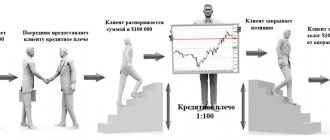Image: Unsplash
When trading on the stock exchange, some investors prefer to use leverage. In this case, they borrow money from the broker to increase potential profits. However, there are big risks here and mainly only experienced traders and investors use this tool.
One of these risks is account drawdown, in which the client’s assets may not be enough to cover liabilities. In this case, a margin call occurs. This is a request from the broker to stop trading from the account to avoid losses. Today we will take a closer look at this phenomenon, look at examples and talk about how to avoid margin calls.
What is a margin call
So what is a margin call? This is a notification that your free margin has reached a critical minimum and you need to top up your account. Let's remember how to calculate free margin.
Free margin is the difference between the total amount in the account and the collateral.
For example, a trader has 750,000 rubles in his account. ($10,000 or 290,000 UAH). Of these, 187,500 rubles. ($2,500 or 72,500 UAH) he cannot use for trading, because this money is blocked in case of need to cover losses. The free margin is RUB 562,500. ($7,500 or 217,500 UAH) (10000-2500).
7500 is funds with which you can trade and open new positions. If all is well, the market is moving in the right direction – the free margin is growing. Otherwise, the amount in the account decreases, and when the loss reaches a certain value, the broker issues a warning. This warning is a margin call.
Naturally, the question arises: what loss is a signal for such a warning? This depends on the terms of the broker, the total amount in the account and the structure of the account. On average, this is about 25-35% of the amount of the guarantee. In our example, the margin call will be triggered when the free margin decreases to approximately RUB 56,250. ($750 or 21,750 UAH) (2500*30%).
Summary
- A margin call occurs when a margin account runs out of funds, usually due to a losing trade.
- Margin calls are requests for additional capital or securities to bring a margin account up to the minimum maintenance margin.
- Brokers may force investors to sell assets, regardless of the current market price, to satisfy a margin call if the investor does not deposit funds.
And that’s all about Margin Call today. I hope the article was useful and interesting for you. Share the article on social networks and instant messengers and bookmark the site. Good luck and see you again on the pages of the Tyulyagin !
What can cause a margin call?
There may be several reasons. Most often, available funds decrease due to the fact that the trader received an incorrect forecast and continues to hold unprofitable positions in the account. Considering that most transactions are carried out using borrowed funds (leverage), the exchange carries risk. One way to reduce such risks is a margin call.
There are also situations that have little to do with small investors. If there has been a massive drop in quotes for assets that make up a significant share of the structure of your account, then, unfortunately, there are only two options: get rid of unprofitable positions or deposit additional funds. And if the market has fallen sharply, maybe it’s worth waiting for time and purchasing additional positions at a bargain price? Let's talk about this further.
Margin trading is a convenient tool for traders and investors
Should you use margin trading? How can it be convenient? Let's list the options where it turns into a convenient tool for a trader.
6.1. Intraday trading
You can make money by trading inside, while having a stable income from bonds. How to do it?
Buy bonds and receive passive income from them. Since intraday margin trading is free, you can make trades on the exchange for free.
For example, we bought OFZ for 1 million rubles. In this case, you can trade intraday for free (we only pay for trading turnover) for an amount of about 5-10 million rubles.
If you can trade successfully, then you can make good money practically for free. After all, the principal amount lies securely at interest. But we take on the risks of losing some of the money from trading.
Remember: 95% of day traders lose money on the stock market. Moreover, because of themselves. Only a small portion of people are able to make money every day.
6.2. Opening short positions
Only borrowed funds allow you to open short positions. Because we cannot sell what we do not have in our portfolio. Short positions are actively used by speculators to make transactions.
Since stocks are prone to growth, it is better for more experienced traders to open short positions. And this is done for short periods of time.
Note: Most stock brokers charge slightly less overnight for short positions than for long positions.
6.3. Opportunity to make advance purchases
There are several options here.
1 The investor knows that he will fund his brokerage account in the evening. Stocks and bonds are rising. In order not to wait for the evening, you can buy them in the morning. Thus, margin trading allows the investor to decide whether to wait for the money to arrive or whether to buy immediately.
Moreover, you don’t have to pay anything for this opportunity to use borrowed funds, since leverage is given without interest during the day.
2 Buy ahead of time. The investor knows that he will replenish his brokerage account in the near future; at the moment, the stock market has fallen significantly (even by 5%). Then you can buy at the drawdown right now. Margin trading doesn't cost that much, in a few days it will cost almost nothing. By this time, the market may recover by 2-3%. Therefore, it makes sense to take advantage of favorable moments to enter the market rather than wait several days for replenishment.
Of course, no one knows whether the market will rise in a few days. Therefore, we are talking about the flexibility that margin trading provides. That is, there is an opportunity to buy, but everyone decides for themselves whether to use it or not.
3 Dividend gap. For example, after the register is closed, the stock opens at minus 7%. You can immediately reinvest future dividend proceeds into the stock. As history shows, when dividends arrive, a stock usually already closes part of the gap. If the investor did not buy in advance, he would miss the opportunity to buy profitably.
In this case, you can play ahead.
6.4. Asset Allocation
Let the investor decide to rebalance the portfolio. He decided to sell the shares and buy the B shares that had fallen in price. In order not to wait for the sale of shares “A”, he can place a purchase order in advance. Thus, you can do two actions at once: buy one asset and sell another.
6.5. Lever to increase earnings
If a trader can trade successfully, then using borrowed funds will improve his performance. Therefore, we can say that margin trading allows you to earn more. But do not forget that in case of failure, the losses will also be greater.
- Is it possible to live on earnings from trading?
- Strategies for trading on the stock exchange;
6.6. Tool for hedging risks
Margin trading allows you to hedge risks. Let's remember what the term hedging means: it is reducing risk by opening opposite positions on financial instruments.
Let's look at examples of how an investor can reduce risks and still make money:
- Given the current situation, there is obviously a weak stock and there is a strong one. You can take large stocks long and weak ones short. Thus, no matter where the market goes, the investor will make money;
- Large spread between depositary receipts in London and the Moscow Exchange.;
- Buying an ETF for the Moscow Exchange index (TMOS, VTBX, SBMX) and shorting a stock that is not growing;
Let us repeat again: margin trading provides opportunities, but the investor decides how to manage them. Hedging also carries certain risks, although it should reduce them. But in some unfavorable moments it can only aggravate the situation.
6.7. Possibility to take out a loan
If an investor is confident in the growth of the stock market or some individual shares, then instead of taking a loan from a bank, it is much easier to take it from a broker. There is no need to sign anything, no need to wait. You simply buy as many securities as you plan and then sell. As a result, this eliminates unnecessary trips to the bank and paperwork.
What should an investor do if the market crashes sharply?
Let's start with the fact that an experienced investor, as a rule, has a safety net and some experience. Crises and market crashes in our country, unfortunately, do not happen so rarely, and it is possible to develop a certain strategy.
Suppose you are a beginner, you have practically no financial cushion, and transactions are carried out using leverage. You trade assets that are highly dependent on oil prices, and then another “Black Tuesday” happened: oil prices fell and the market collapsed. How to proceed?
First of all, don’t give in to panic. Today the value of securities is decreasing, but over time it will certainly increase. The question is when? Predictions rarely come true, and each negative situation is not a repetition of the previous one. Therefore, guessing on the coffee grounds is also not an option.
Analyze how many percent the quotes fell in a couple of days. Let's assume there was a 20% price reduction. Then it is worth selling approximately 20-25 percent of your positions on which the greatest loss was received. But you shouldn’t sell everything at once - your panic will only increase someone else’s profit. Doing the opposite and continuing to hold such positions, waiting for them to reach the “bottom”, is a risk that can be afforded by those who have a substantial supply of free money. For a novice trader, this is not a very good course of action.
What to buy with the proceeds? You can purchase assets from another industry that is not so shaken right now. Let's say tech stocks. You can buy bonds that are known to have low volatility. Or you can simply deposit money into your account without allowing the free margin to fall to a critical level. In any case, the main thing to remember is that a global collapse, as a rule, does not last that long. Very soon the market will begin a slow upward movement.
A margin call is certainly a very unpleasant situation. But if this does happen, don't panic. Calculate the minimum at which you can avoid a stop-out (forced closure of a position), and deposit this amount into the account by selling part of the unprofitable assets. When the market is down, this is easy to do. If margins start to fall back to their lows, do the same without waiting for a warning. You may have to trade in this turbulent mode for some time. But you will gain experience in diversification and develop a strategy for dealing with critical situations.
What else to read and watch
We published a selection of trading courses on our website. I recommend that you watch it and take only the free courses that are described there. You will always have time to throw away money on paid ones.
When you have read the selection, read my article “Is it possible to make money from trading.” I wrote it because right now I don’t consider trading at all as an opportunity to consistently make money. About five years ago I still believed that traders could make stable money, but now I don’t believe it anymore. Look at the arguments I make, I hope they make you think.
If you don't have money, consider looking for remote work. In this regard, I can recommend you our three selections:
- Courses on remote work. The most general selection, there are a lot of paid and free courses, which are sorted into categories.
- Courses for mothers on maternity leave. A separate collection of courses that young mothers often study. Maternity leave is an excellent opportunity to acquire a new profession.
- Copywriting courses. I especially recommend it, because copywriting, in my opinion, is the most reliable and promising area of freelancing. From a copywriter you can easily grow to a content manager, editor and owner of your own web projects.
If you have money, invest. Please note that you need to invest, not speculate.
To begin your “immersion” in the world of investing, watch these two webinars from the City of Investors.
- Investment portfolio for $100 per month - in this webinar, Evgeny Khodchenkov will tell you how to create a portfolio of securities in an evening that will bring about $100 in profit per month. You will also learn how to rebalance this portfolio, that is, how to supplement it with new securities, monitor profitability and risks.
- Investments without a million in your pocket - the webinar will give you a clear plan for generating passive income from investments of 500 and 1000 rubles. You will learn how and where to invest small amounts of money to gradually become richer and richer.
Recently, another online marathon “How and where to invest in 2021” was launched in the City of Investors. It lasts ten days, during which you will learn the entire theory of investing and try to invest money in financial instruments yourself.
Check out the YouTube channel that Ak Bars has recently launched. Ak Bars is a bank that at the same time gives people the opportunity to make investments. Here is an example of one of the recorded webinars, take a look.
What is the difference between a stock exchange margin call and the Forex market?
You can start trading on the stock exchange even with 5,000 rubles, but for a comfortable start you need several tens of thousands of dollars.
What is a margin call in the stock market? This is the situation described above: available funds amount to 30 percent or less of the amount of the guarantee.
On the stock exchange, the leverage is 1:2 – 1:4 (much less than on Forex) and brokers’ requirements are much higher. This is primarily due to higher risks.
On Forex, leverage can be 1:100 or higher. A significant part of traders work with a small deposit, therefore the level for margin calls will be higher - 50-90% of the deposit amount.
How to Avoid a Margin Call
In simple terms, a margin call is a red flag that is a sign that your account is on the verge of being closed. How to avoid this?
- Limit the amount of leverage. The more equity you use in trading, the less likely it is that a margin call will occur.
- Get rid of unprofitable positions in a timely manner. Do not “wait out” the time of drawdown, relying on intuition and forecasts. There are special tools (stop orders) that allow you to automatically get rid of weak positions.
- Calculate the volume of transactions and their number.
- Diversify your portfolio.
- Do not use the “pyramid” strategy, in which many orders are opened, then the most profitable ones are closed, and the unprofitable ones are left to wait until they begin to make a profit. This strategy is especially not recommended for beginners.
Under what circumstances can MK and Stop Out occur?
Knowing the variability of FR indicators, experienced traders recommend understanding the moments when the probability of the occurrence of MC or SA increases. For example, trading conditions and asset prices may change between Saturday and Sunday when the exchange is closed.
Given that events in the political and economic life of different countries change every minute, you need to understand that an unclosed transaction may be subject to a collapse (gap in stock exchange slang) at the beginning of a new trading session.
Changes in quotes are affected by:
- political courses of leading countries;
- events in economic life;
- jumps in currency pairs and other indicators over the weekend.
The political course of the leading countries of the world affects the value of shares of certain companies, exchange rates and the value of valuable assets. For example, a war started in an area where oil is produced can increase its price on the FB. Changes in the economic sector have the same impact.
Significant gaps occur between Friday and Monday. For example, in the ratio of currency pairs there may be an advantage in one direction or another, which will affect the profitability or unprofitability of an unclosed transaction.
To avoid the onset of MK and SA, experts recommend:
- conclude deals on time (before a news release);
- It is not recommended to leave items overnight (for example, from Thursday to Friday);
- monitor world events;
- trade before news with a smaller volume (2-3 times).
What is the benefit
It would seem that there are only negatives: the account is on the verge of being closed, the broker is taking risks. However, there are also positive aspects. What benefits can be gained when a margin call is triggered?
For the investor
First of all, a margin call is a chance (perhaps the last) to save your account. If, after receiving a warning, the investor takes some active actions (deposits funds, gets rid of unprofitable positions, etc.) - there is a chance of avoiding collapse. In addition, a margin call guarantees the safety of the collateral and will not allow you to increase the debt.
For broker
The broker thus reduces his risk - because the funds provided as leverage are at risk. In an unfavorable situation, he has the opportunity to quickly sell assets, the cost of which falls within the amount of the pledge.
Conclusion
You can gain profit by trading only with your own funds. You can remain at a loss for a long time without the risk of using leverage. The only thing that is impossible in the market is to constantly be on margin.
A personal investment strategy should include a reversal of positions, taking into account the changed trend, and even a stop loss . If you do not promptly respond to the alarm bell ringing ( margin call ), the problems will only get worse.
Any trader should carefully monitor price dynamics. You cannot rely solely on the stop losses you set. They may not work.
If the president had signed a law on a tax on bank deposits and bonds on the eve of the weekend, no stop loss would have saved us from a gap and losses. Thank you for your attention, always your Maximum income!
Risks
There is a direct relationship between the share of borrowed funds in trading and the level of risk. In simple words, a margin call is a risk limit, after overcoming which losses will cover the amount remaining in the account. Main risk factors:
- Opening a large transaction for the entire amount of available funds.
- Leverage that exceeds the transaction value by 100, or even 1000 times.
- Unfavorable situation in the market as a whole.
As you can see, all factors except the last one are within the sphere of influence of the investor. One has only to add that the status of the account must be constantly monitored, including on weekends.
Calculating Margin Levels
The margin level depends on the ratio of own funds on deposit and collateral. It is calculated using the formula: funds/collateral*100%.
In addition, you can measure the margin level by converting average internal volatility (AIV) into price movement by points. You can find out the SVV indicator by finding the square root of the average sum of daily deviations for the selected period. In this case, the loss threshold margin must be 3 or more for the required points.
Exchange indicators of volatility and other criteria are freely available on world stock exchanges. The calculations take into account the market's reaction to similar news in the economic or political sphere.
Margin call table as an example
Let's calculate margin calls on the stock market using an Excel spreadsheet. Let’s assume that the trader’s deposit amount is 600USD, which is used to purchase shares of companies A, B and C using a leverage of 1:3.
| Name | Price, $ | Quantity, pcs. | Cost, $ | Own funds, $ | Leverage, $ | Margin call, % | Margin call, $ |
| A | 50 | 20 | 1000 | 333,3333333 | 666,666667 | 33,33333333 | 222,222222 |
| B | 30 | 10 | 300 | 200 | 100 | 66,66666667 | 66,6666667 |
| C | 10 | 50 | 500 | 66,66666667 | 433,333333 | 13,33333333 | 57,7777778 |
| TOTAL: | 90 | X | 1800 | 600 | 1200 | X | X |
| Deposit | 600 |
So, the margin call on position A will occur when its value decreases by 33.33% and amounts to 222.22USD:
\[ MC(A)=(1000-666.67)/1000*100=33.33\%. \]
The share of own funds attributable to financing shares of company A, at a critical level, will be: 333.33-(333.33*33.33%)=222.22USD.
Similarly, you can calculate the margin call for shares of companies B and C:
Calculation example
Let's consider the situation of a stop out using the example of buying Gazprom shares. Let’s say an investor had the following initial data on March 4, 2021:
- deposit amount is 10 thousand rubles;
- the price of the lot at the time of purchase is 2000 rubles. (10 shares for 200 rubles);
- initial margin 31%.
Under such conditions, he could purchase 16 lots with a total cost of 32 thousand rubles.
On March 10, Gazprom’s share reached 171.2 rubles, i.e., our investor’s position decreased to 27,392 rubles. All losses are borne by his deposit, and not by the broker who provided the loan. This means the player lost 4,608 rubles. There are 5,392 rubles left in his account. Let's determine the minimum margin. It is calculated by multiplying the current price of an asset by its minimum risk rate. On March 10, 2021, the minimum risk rate for Gazprom shares was 20%. The minimum margin takes a value equal to RUB 27,392. x 20%, which is 5,478.4 rubles. Thus, we learned that the investor, if he ignored the margin call, had a stop out shortly before the close of trading on March 10th.
I also recommend reading:
Review and independent review of the Score Priority broker
Just2Trade renamed to Score Priority, reasons and consequences
The example considers a short tenure of securities, so the cost of using leverage is not taken into account. Broker commission is also excluded to simplify settlements.
The reason for margin calls and stop outs can be not only asset drawdown, but also an increase in the minimum risk rate. For example, from March 11, 2020 for Gazprom it is 25%. If we calculated the minimum margin based on this indicator, it would be 6,848 rubles. Thus, increasing this threshold protects traders’ money in conditions of increased volatility.
The deposit size at which the investor will receive a margin call notification is calculated according to the same principle: the current price of the asset is multiplied by the risk rate determined by the exchange.
Flaws
So, we have given the advantages of margin calls a little higher, and now let’s talk about the disadvantages. In fact, a margin call in itself is a negative phenomenon. Rather, here you need to pay attention to the fact that it is quite difficult to independently predict the imminent appearance of “Uncle Kolya” - as margin calls are called in slang.
From the table above it can be seen that calculating the critical level manually, especially for many positions, is a labor-intensive and tedious task. As a rule, you can see the margin call level on the trading terminal. In Forex, this level is usually approximately 100%.
In order to prevent a margin call, you must have risk management skills and determine the mathematical expectation of a trading strategy. In simple words, a margin call is dangerous because calculating its imminent occurrence is a difficult task for beginners. The only thing that can be advised is to monitor the level of margin and try to ensure that its size exceeds the critical level several times.
Examples
Let's calculate the margin call for the Forex market.
Conditions:
- cost of the euro/dollar currency pair: 1.1649USD;
- deposit size: 1000USD;
- lot – 0.1;
- leverage – 1:100;
- critical margin level – 100%.
Margin: 116.49USD.
Margin when opening a transaction = 1000/116.49 * 100% = 858.44%.
\[ MC=1000-116.49=883.51 USD. \]
Thus, the broker will send a warning if a loss on this transaction is received in the amount of RUB 66,263. ($883.51 or 25,622 UAH).
Let us explain another example in simple words. Let’s say a trader wants to purchase 2 lots (15,000,000 rubles (200,000 $ or 5,800,000 UAH)) for the USD/EUR pair.
The broker provides leverage of 1:200. This means that 14,925,000 rubles will be paid from borrowed funds. ($199,000 or 5,771,000 UAH), and 75,000 rub. ($1,000 or 29,000 UAH) – own funds used as collateral.
When the transaction is closed, the borrowed funds will be returned to the broker, and the trader will receive his 75,000 rubles back. ($1,000 or 29,000 UAH) plus profit from the transaction. Or money minus the loss if the deal closes with a minus.
But please note: the trader’s deposit amount must significantly exceed the deposit. If the market moves in an unfavorable direction, losses will be deducted from available funds. When this money runs out, margins will begin to decrease.
So, a margin call can occur with a margin of 100% (75,000 rubles (1,000 $ or 29,000 UAH)) or a little less (depending on the broker’s conditions). Further, if the account is not replenished, the transaction will be closed via stop out with a loss.
Types of shortage of funds on deposit
When touching on the topic of margin call, it is definitely worth briefly mentioning stop-out along with it, although there is a separate article for this latter that reveals all the nuances. So let's get started.
To begin with, let us remember that financial speculative activity is carried out by traders using a margin trading system. That is, the broker provides its clients with leverage, which allows them to turn around a large capital with a small deposit, receiving decent profits from it. For Forex, the standard leverage size is considered to be 1:100, and more aggressive trading with the help of trading advisors even allows the level to reach 1:500 or even 1:1000.
Such sizes are unusual for the stock and derivatives markets, since you rarely see more than 1:20 there. But the point in all cases is that the trader trades using the broker's borrowed capital. With such a mechanism, the intermediary needs guarantees. Therefore, when providing a loan, the broker freezes part of the funds in the client’s account, which act as collateral for opening a position.
Further, this amount of frozen capital may vary depending on the broker’s trading conditions and the market situation. For example, if a position suffers losses, then the broker, to protect its interests, will require a larger amount from the trader to secure the current transaction. In this regard, every experienced trader, when calculating the volume of a transaction, always makes sure that in the event of an unsuccessful development of events, he has enough money in his account to ensure the maintenance of the position.
If there is not enough money, then the so-called Margin Call occurs. But more about it later. For now, let’s give an example of how this is displayed in the popular MetaTrader 4 (MT4) terminal and its newer 5th version, since they are used by the overwhelming majority of all Forex traders.
So, open the terminal, make a transaction and pay attention to the lowest tab “Trading”, which looks like this.
Here, in the line highlighted in gray, there are several parameters that need to be taken into account when working on the Forex currency market:
- The first parameter Balance shows the general status of the account and the amount of available funds accumulated by replenishing the deposit and taking profits.
- Next comes the Equity parameter, which shows how the Balance changes during an open transaction - if there is a profit on the current position or positions, then its size is summed up with the balance and displayed as a single number, but in case of current losses, their value is subtracted from the balance amount, showing the trader the real state of affairs on the deposit.
- The Margin value gives the trader information about how much funds from the balance are “frozen” and cannot be spent on securing new transactions.
- The Free Margin parameter, as opposed to the previous one, tells how much money from the deposit can be used to open new transactions.
- And the last value Level (Level) Margin Call gives an idea of how much free funds the trader has available, but this parameter is displayed as a percentage. This makes it easy to assess how strong the current load on the deposit is. This value is easy to read - the higher it is, the better.
The trader must constantly monitor the Level in his trading, since at certain values it is the Margin Call and Stop Out that occur. Here you need, first of all, to know how the broker’s margin call is calculated, which we will discuss below.










